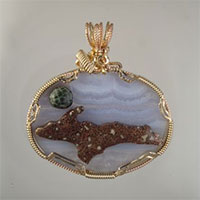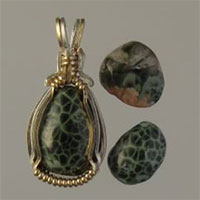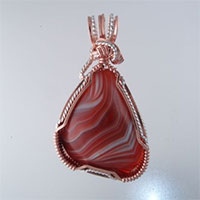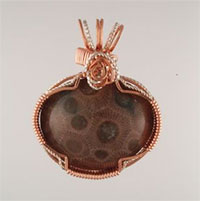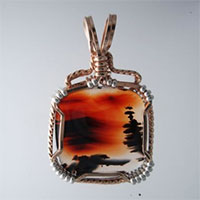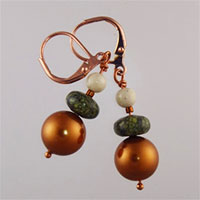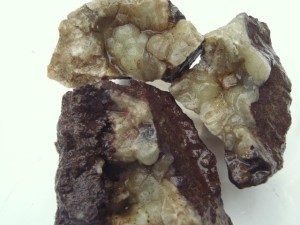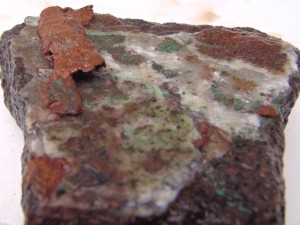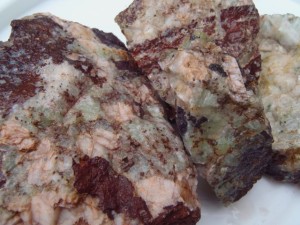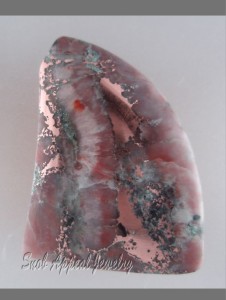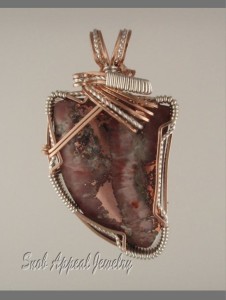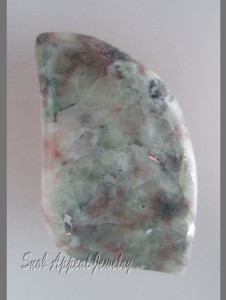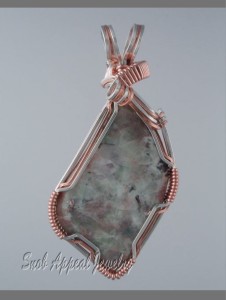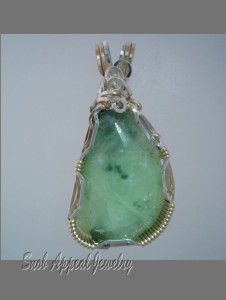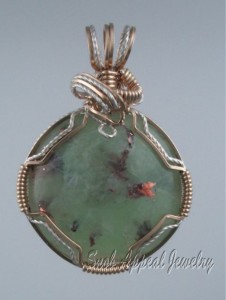Here’s a little trivia you may not know about the mineral Prehnite: The first modern mineral to be named for a person was…..PREHNITE. Abraham Gottlob Werner of the Freiberg Mining Academy, was a popular teacher, but is also credited for delaying the advance of Geology by insisting upon wrong concepts on the origin of rocks and minerals. He WAS successful in classifying minerals. Werner named the mineral Prehnite after Col. von Prehn after von Prehn brought the mineral to Europe from the Cape of Good Hope (1783), where he found it.
I love rock trivia. I found this knowledge in a 45 year old book I have. Let’s take a look at some of the variations of Keweenaw Prehnite. Where possible I will show the cabochon before it became jewelry.
Prehnite is a Copper Associate Mineral in Copper Country. Much of the Prehnite contains copper dust that changes green Prehnite to pink Prehnite. Other inclusions in Prehnite also produce a plethora of colors. Zeolites sometimes mix with Prehnite (A calcium Aluminum Silicate) in the Keweenaw and produce feathery eyes and patterns. Copper and Chlorite included Prehnite is sometimes referred to as “Patricianite” by copper country locals.
Pastel Prehnites roll up on the beaches all along the west side of the Keweenaw Peninsula. While looking for agates, beachcombers may see a bright pink stone shimmering among other dull stones. Pick it up, it might be a coppery beauty. These nuggets can have pink and green together, sometimes even purple tones. I have found Prehnite in piles of materials cleared from road construction not far from Calumet. Prehnites are also gleaned from rock spoil piles at some mines. I have a secret hole that I also occasionally excavate for Prehnites. The best Prehnite has always been associated with Austraiia, but gemmy pastel green Keweenaw Prehnite with Copper inclusions, in my opinion, gives the Aussie stuff a run for the money.
Prehnite is sometimes referred to as U.P. Thomsonite because its’ appearance often mimics Thomsonite, with eyes, radiating sprays, and variegated inclusions. Some Prehnite is difficult to tell from Thomsonite, or other Zeolites, and for many years Prehnite was thought to be a Zeolite. It was determined by Analysis by Michigan Tech geologists that Prehnite is not related to the Zeolites, but can be associated with Zeolites. Prehnite is a Calcium Alumosilicate. More confusing is when Zeoiles mix with Prehnite and make the Prehnite look exactly like Thomsonite. Thomsonte is almost an exclusive American Gemstone (more trivia for you guys), Prehnite is much more scattered and can be found in numerous locales around the world.
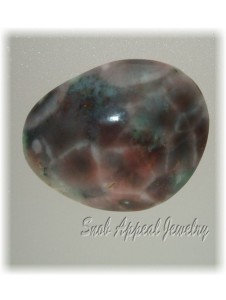
A beautiful oddball dug from a hole somewhere in the Keweenaw Peninsula. Prehnite, assorted Zeolite and other stuff. A beautiful mix, don’t you think?
The Apple Green Prehnite from the Keweenaw can be found as small round Crystals, but in most cases as slim veins in the Amydaloidal basalt. I have found much of the Prehnite in my collection in veins that are less that one inch. The Prehnite seems to form within a void from the outside in, meeting in the middle of the void. After extracting the Prenite bearing host basalt, I usually split the Prehnite where it meets in the middle. I can then use both sides to make beautify cabochons and jewelry. I like when the Prehnite sometimes does not completely close off in the middle of the seam, leaving a void where Prehnite Crystals form in a drusy. Remember it is often possible to find copper within the U.P. Prehnite. Copper can be found included in most every Keweenaw mineral.
The Seaman Mineral Museum, in Houghton, Michigan, has some wonderful, large Prehnite crystals found by miners over the years. Knowing that a Mine Captain or Superintendant or other mine management person was a mineral collector, the miners could score some points by turning these specimens over to them. Some of the finest specimens at the Seaman Museum were from these historic collections donated to the museum by heirs or willed by the owners of the collections.. Two of the most prolific collectors were J.T. Reeder, who clerked at several different mines, and L.L. Hubbard who discovered the Champion Mine and served as general manager of the mine. It is interesting to read and learn about these early collectors. Hubbard willed some of his collection to the University of Michigan, and recently the U of M has given many Copper Country specimens, from historic collections, to the Seaman Museum.
Many rockhounds overlook Prehnite or Patricianite while rock collecting in the Keweenaw. it’s one of my favorites and I never miss a chance to pick up nice pieces. So what do you think? Does Prehnite/Patricianite make good jewelry? You are invited to visit my jewelry pages to see the variety created from Keweenaw Treasures, especially Prehnite .


